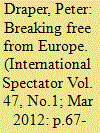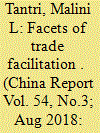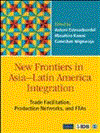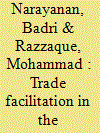|
|
|
Sort Order |
|
|
|
Items / Page
|
|
|
|
|
|
|
| Srl | Item |
| 1 |
ID:
111547


|
|
|
|
|
| Publication |
2012.
|
| Summary/Abstract |
Support for regional economic integration in Africa runs high amongst the continent's international development partners and African elites. However, its expression in European forms of economic integration is not appropriate to regional capacities and in some cases may do more harm than good. This lacuna is exacerbated by technical and theoretical analyses rooted either in economics or international relations literature. This article sets out to reconceptualise the foundations of African economic integration by reviewing key debates within each literature and comparing the results across disciplinary boundaries. Overall, it is concluded that a much more limited approach is required, one that prioritises trade facilitation and regulatory cooperation in areas related primarily to the conduct of business; underpinned by a security regime emphasizing the good governance agenda at the domestic level. Care should be taken to design the ensuing schemes in such a way as to avoid contributing to major implementation and capacity challenges in establishing viable and legitimate states. In doing so, the presence of regional leaders with relatively deep pockets - South Africa in the Southern African case - points to the imperative of building such limited regional economic arrangements around key states.
|
|
|
|
|
|
|
|
|
|
|
|
|
|
|
|
| 2 |
ID:
178484


|
|
|
|
|
| Summary/Abstract |
Using data on firms listed on Chinese A-share markets from 2009 to 2017, this paper applies the difference-in-difference model to test the effect of trade facilitation on preventing the formation of zombie firms. We find that the China Railway Express (CRE) significantly prevented the formation of such firms. Mechanism tests show: (i) the CRE has accelerated the speed of sales, which increased the overseas sales revenue of firms; (ii) the economies of scale and the capital accumulation effect caused by the CRE can help increase firms’ solvency and development ability. Heterogeneity analysis indicates that the effect of the CRE on preventing the formation of zombie firms is mainly reflected in non-state-owned firms, firms in highly competitive industries, and firms in the eastern region of China. We suggest that China should continue to promote trade facilitation by expanding the CRE and strengthening the market's dominant role in preventing the formation of zombie firms. Disadvantaged firms should seize the development opportunities brought by the CRE.
|
|
|
|
|
|
|
|
|
|
|
|
|
|
|
|
| 3 |
ID:
160496


|
|
|
|
|
| Summary/Abstract |
The theoretical underpinnings of trade facilitation (TF) would suggest a ‘balanced growth’ approach to expedite trade. However, taking the example of China and India, in this article, we explore how selective measures are capable of addressing issues related to TF. Both the economies offer very innovative interventions to address issues corresponding to TF, especially embedded in the way institutions are coordinated and integrated. As against the conventional idea that TF has to be initiated and carried forward only by the government, the ‘One Touch’ initiative in China provides a role for public–private partnership on issues pertaining to TF. This clearly demonstrates how, besides generating demand for trade-logistics services, the private sector itself can act as a source of supply to such services. The operation of Grapenet in India highlights the need to focus on sector-specific TF requirements along with meeting multilateral obligations. The One Touch initiative has to be appreciated as it was brought about in a context of the limited evolution of the information technology (IT) platform in China, and Grapenet has to be appreciated specifically because it brought a paperless integrated system in an agricultural context in India, where this sector’s preparedness for TF is less than that of the manufacturing sector.
|
|
|
|
|
|
|
|
|
|
|
|
|
|
|
|
| 4 |
ID:
135742


|
|
|
|
|
| Publication |
New Delhi, Sage Publications, 2015.
|
| Description |
xiv, 311p.Hbk
|
| Standard Number |
9788132109761
|
|
|
|
|
|
|
|
|
|
|
|
Copies: C:1/I:0,R:0,Q:0
Circulation
| Accession# | Call# | Current Location | Status | Policy | Location |
| 058082 | 382.91/EST 058082 | Main | On Shelf | General | |
|
|
|
|
| 5 |
ID:
147332


|
|
|
|
|
| Summary/Abstract |
This article examines the economic impact of trade facilitation between Commonwealth country members, using a global computable general equilibrium framework. We document enormous economic impact, much higher than a complete tariff liberalisation amongst these countries. The economic impact is quite visible in terms of welfare, gross domestic product, employment and trade in several sectors. We abstract from the costs involved in such trade facilitation—accounting for them is beyond the scope of this study.
|
|
|
|
|
|
|
|
|
|
|
|
|
|
|
|
| 6 |
ID:
175351


|
|
|
|
|
| Summary/Abstract |
Higher trade costs in developing countries have received enormous attention during the recent past. In this context, it is imperative to revisit the factors contributing to such higher trade costs. This article attempts to explore the major determinants of trade costs conceptually and empirically. Further, the study endeavours to solve the puzzle of higher trade costs in the South Asian perspective. Using panel data of 93 countries from 2007 to 2015, the study tends to uncover major determinants of trade costs between South Asian countries and their two proximate regional blocks, namely Asia-Pacific Economic Cooperation (APEC) and Association of Southeast Asian Nations (ASEAN). In estimating the model, the study prefers to use fixed-effect estimation technique, owing to the results of statistical tests carried out to choose the most appropriate model for the estimation. The findings of the study reveal that trade facilitation, political corruption and financial development affect intra-regional trade costs of South Asia significantly. Trade facilitation influences trade costs between South Asia and ASEAN. Moreover, trade facilitation and financial development affect trade costs between South Asia and APEC. The diagnoses of South Asian intra and inter-regional trade costs can push forward ongoing efforts at unlocking the potential of regional integration as well as global integration of the region.
|
|
|
|
|
|
|
|
|
|
|
|
|
|
|
|
|
|
|
|
|